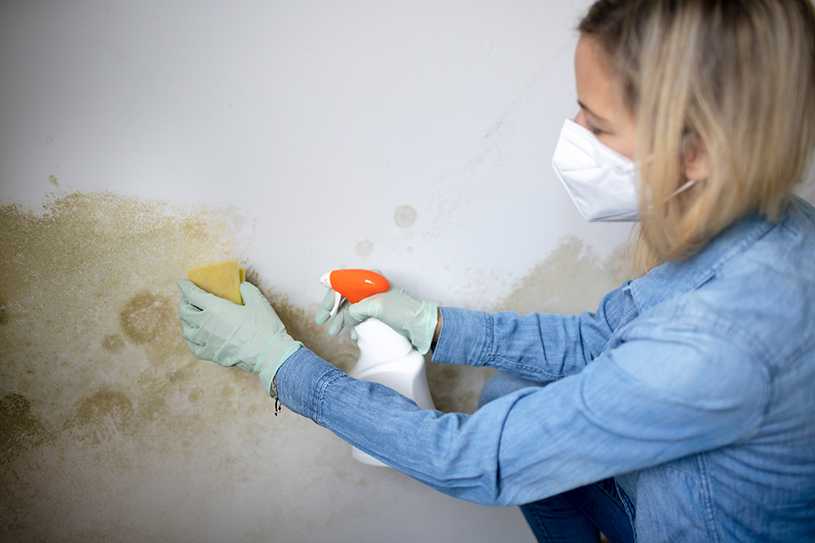How to get rid of mould in your rental property - Simply Business knowledge

A build up of mould can be a serious health hazard and impact the lives of your tentants, so it's important that you understand your responsibilities as a landlord.
Read on for a reminder of the law and tips on how to get rid of mould in your rental property.
Is mould the landlord's responsibility?
As a landlord it's your legal responsibility to make sure your property is fit for people to live in and free from hazards.
While there's legislation around damp and mould (it's a category 1 hazard under the housing health and safety rating system), the government is facing increased pressure to make sure the law is fit for purpose.
The English Housing Survey found that almost a quarter of private rental homes don't meet the Decent Homes Standard in 2020-21. And problems with damp and mould are likely to be even greater due to soaring energy bills and the cost of living crisis.
While the Decent Homes Standard is only mandatory for social housing, the government is reviewing this for the private rental sector and it's likely to become law later in 2023 as part of the rental reforms.
What causes mould?
The most important thing when it comes to removing mould is knowing what caused it in the first place, so that once you get rid of it, it won't come back.
Mould is generally caused by damp conditions, but there could be all sorts of reasons the damp is occurring. Most people think of damp as being cold, but hot, humid conditions are also a breeding ground for mould.
One of the main causes of damp is condensation, which is why you often find mould in bathrooms. If your bathroom - or any rooms in your property – aren't properly ventilated then moisture can build up and mould can start to spread.
However, if condensation isn't an issue for your property then you may have a more serious problem. This could be a burst pipe or damage to your property allowing rain to get in, or something harder to resolve like rising damp.
How to prevent the growth and spread of mould
Proper ventilation is the key to avoiding mould that's caused by condensation. A good first step is to make sure you have an extractor fan installed in your kitchen and bathroom. If your property is a newer build, then it will likely have them already as extractor fans legally required. But for older properties you may want to think about getting one fitted.
If your property is already suffering from damp, dehumidifiers can be used to dry things out before you start to remove the mould. Though you can't control your tenants future behaviour, if the property is empty while you solve the problem make sure to keep it properly heated and open the curtains during the daylight hours.
You can also decorate your property in a way that will help prevent the spread of mould. Using anti-mildew paint in areas prone to mould will help prevent it from growing, while using a curtain pole that keeps your curtains set further back from the windows will make them less likely to get damp.
General tips for removing mould
When you get down to removing the mould, make sure you wear protective clothing: rubber gloves, safety goggles and a dust mask will protect you from both the mould and its spores as well as the contents of the cleaning products you use.
You should also make sure the area is well ventilated – open a window if you can, or make sure your extractor fan is turned on if not.
Mould and mildew thrive on dirt, so once you've removed it make sure to give your entire property a thorough clean. This will help to remove any lingering spores that may cause the problem to recur.
Keep reading for specific information on how to remove mould from anywhere in your house.
How to remove mould from walls
Choose a mould remover spray or create your own from one part bleach to five parts water
Using a stiff bristled brush, scrub the affected area. If you have wallpaper, be careful not to damage it
Rinse the area with water
Dry thoroughly using a cloth
How to remove mould from furnishings
The best way to remove mould depends on what type of furnishing you're cleaning.
How to remove mould from soft furnishings and upholstery
If possible, take the item of furniture outside and place it in direct sunlight. The sunlight will help kill the mould and being outside will make cleanup easier
Using a broom or stiff bristled brush, sweep areas where there is visible mould. Do not sweep outside these areas or you may spread the spores further
Vacuum the affected areas using a brush attachment
Mix together detergent and warm water and use the suds to clean the area
Leave in the sunshine to dry, or in a warm, well ventilated room
How to remove mould from wooden furniture such as tables and cabinets
Vacuum up any dry, loose spores from the affected area
Using a specialist mould remover or a few drops of ordinary detergent mixed in warm water, clean the area with a well-wrung cloth
Rinse with water, making sure not to soak the item you're cleaning
Dry thoroughly using a fan - if wood is left wet for too long it may spoil
Comments
Post a Comment